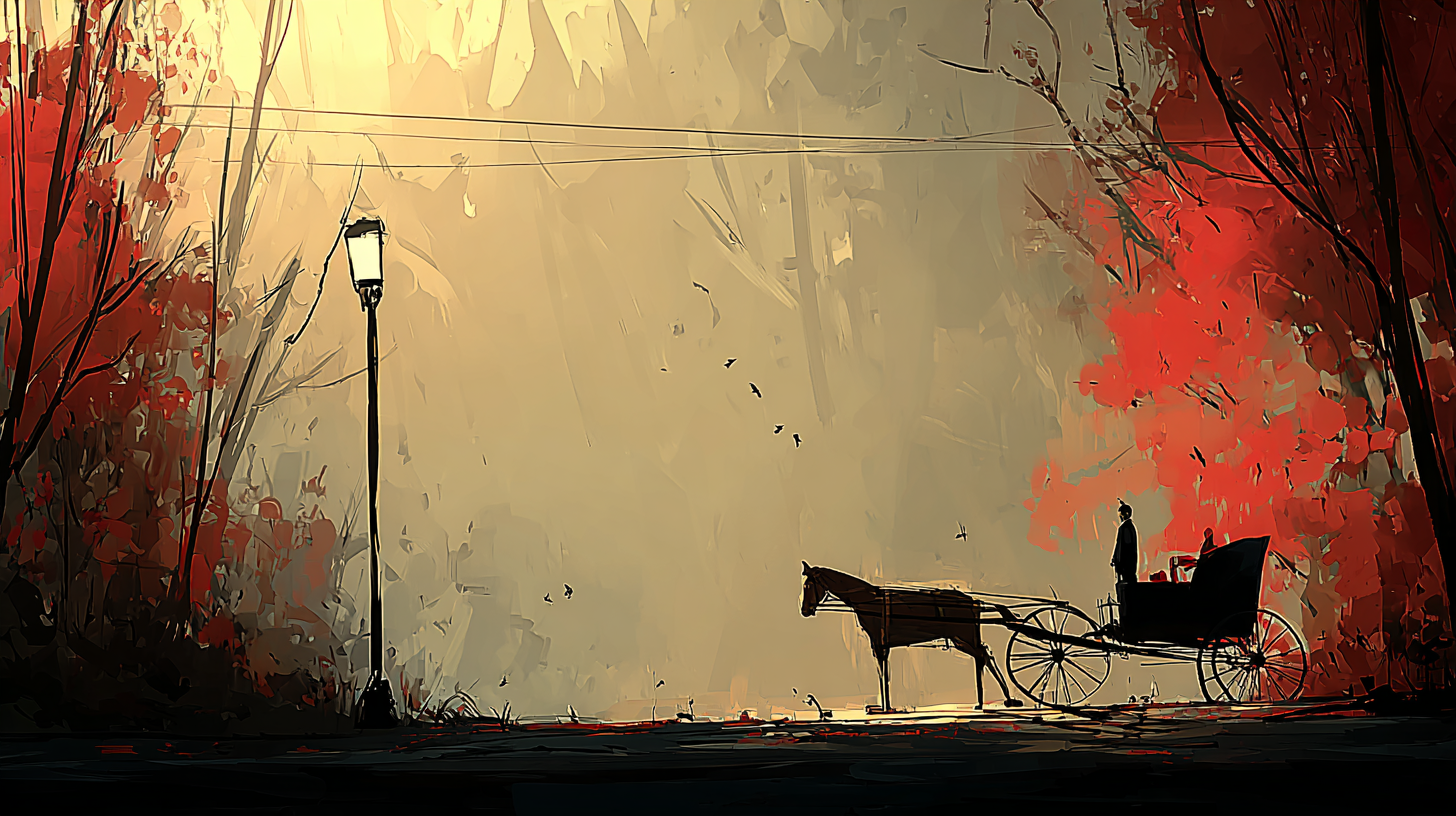A carriage is something that carries people or things, like a train car or a horse wagon.
carriageは、人や物を運ぶための乗り物や機械の部分のこと。
以下は英単語 “carriage” に関するストーリー型学習コンテンツです。まずは大枠の意味を理解して最後の文章で確認しましょう。
「carriage」の主な意味(main meaning)
| 品詞 | 意味 | 発音記号 | 英語例文 |
|---|---|---|---|
| 名詞 | 馬車(人を運ぶ乗り物) | /ˈkærɪdʒ/ | The royal family arrived in a beautiful horse-drawn carriage. |
| 名詞 | (列車の)車両、客車 | /ˈkærɪdʒ/ | We found our seats in the third carriage of the train. |
| 名詞 | (機械の)可動部分 | /ˈkærɪdʒ/ | The typewriter’s carriage moved smoothly from left to right. |
「carriage」の語源(etymology)
語源は古フランス語 carriage(運搬)、さらにラテン語 carrus(車)に由来。
核となるイメージは「何かを運ぶもの(運搬する手段)」。
「carriage」の類義語(synonyms)
| 類義語 | 英文例 |
|---|---|
| wagon | The farmer loaded hay onto the wagon. |
| coach | The tourists traveled in a comfortable coach. |
| train car | We switched to another train car because it was quieter. |
| buggy | The baby was asleep in the buggy. |
| vehicle | That vehicle is not allowed on the pedestrian path. |
「carriage」の反義語(antonyms)
| 反義語 | 英文例 |
|---|---|
| stationary object | The statue is a stationary object, not meant to move. |
| pedestrian | A pedestrian walked slowly beside the road. |
「carriage」のコロケーション(collocations)
| コロケーション | 英文例 |
|---|---|
| horse-drawn carriage | They rode through the park in a horse-drawn carriage. |
| train carriage | The train carriage was full of passengers. |
| royal carriage | The queen waved from her royal carriage. |
| carriage ride | We enjoyed a peaceful carriage ride around the city. |
| baby carriage | She pushed the baby carriage gently. |
「carriage」の2項表現(binomials)
| 表現 | 英文例 |
|---|---|
| carriage and horse | The parade featured an old-fashioned carriage and horse. |
| coach and horses | They arrived at the wedding in a coach and horses. |
英語ストーリー(english story)
Title: A Ride to Remember
On a sunny morning, Emma arrived at the train station. She was traveling to the countryside to visit her grandmother. As she stepped into the carriage of the train, she found a window seat and smiled. The train began to move, and she watched the city disappear behind her.
When she arrived at her destination, her grandmother was waiting outside—with a surprise. “Would you like a carriage ride?” she asked. Emma looked and saw a horse-drawn carriage ready for her. It reminded her of old stories she had read in books.
The carriage moved slowly through the village. People waved, and children ran beside it. The coachman told stories about how the royal carriage had once passed through the same streets.
Later, they visited a museum. One of the displays showed an old printing press. The guide explained how the carriage of the machine held the paper and moved back and forth. Emma was amazed to learn that “carriage” also meant a part of a machine.
That evening, Emma and her grandmother drank tea and laughed. It had been a ride to remember—in more ways than one.
和訳
タイトル:思い出に残る乗り物体験
ある晴れた朝、エマは電車の駅に到着しました。彼女は田舎にいるおばあちゃんを訪ねるために出発するところでした。列車の**carriage(客車)**に乗り込んだ彼女は、窓際の席に座ってほほえみました。列車が動き出すと、町の景色が後ろへ流れていきました。
到着すると、おばあちゃんが駅の外で待っていて、こう言いました。「carriage ride(馬車の乗車)、どう?」エマが見上げると、**horse-drawn carriage(馬車)**が彼女を待っていました。まるで本で読んだ昔のお話のようでした。
**Carriage(馬車)は村をゆっくりと進みました。人々が手を振り、子どもたちが横を走っていました。御者は、かつてこの道をroyal carriage(王族の馬車)**が通った話をしてくれました。
その後、2人は博物館を訪れました。展示には古い印刷機がありました。案内人が、「この**carriage(機械の可動部分)**が紙を支えて前後に動くんです」と説明しました。エマは“carriage”が機械の部品の意味もあることに驚きました。
その晩、エマとおばあちゃんはお茶を飲みながら笑い合いました。まさに「思い出に残る乗り物体験」になったのです。
「carriage」のQ&A
- Qcarriage の類義語にはどんなものがありますか? それぞれの違いも知りたいです。
- A
wagon(荷物用の馬車)、coach(乗客用の大きな馬車や長距離バス)、train car(列車の1車両)、buggy(小さな馬車やベビーカー)、vehicle(乗り物全般)などがあります。carriageは人や物を運ぶ乗り物という意味で、特に馬車のイメージが強いです。
- Qwagon と carriage の違いは何ですか?
- A
wagon は荷物を運ぶための四輪の馬車を指すことが多く、carriage は人を運ぶための乗り物として使われます。
- Qcoach と carriage の違いは何ですか?
- A
coach は多人数を乗せるための大型の馬車や長距離バスを意味するのに対し、carriage はより小型で上品な馬車や列車の客車なども含みます。
- Qcarriage の反義語にはどんなものがありますか?
- A
stationary object(動かないもの)、pedestrian(歩行者)などが反対の概念として使えます。carriage は「運ぶ・移動する」イメージなので、動かないものや自分で歩く人が反対の意味になります。
- Qpedestrian はどうして carriage の反対になるのですか?
- A
carriage は人を「運ぶ」乗り物ですが、pedestrian は自分の足で「歩く」人を意味するので、移動の手段が正反対だからです。
- Qよく使われる carriage のコロケーションにはどんなものがありますか?
- A
horse-drawn carriage(馬車)、train carriage(列車の車両)、royal carriage(王族の馬車)、carriage ride(馬車での移動)、baby carriage(ベビーカー)などがあります。よく一緒に使われる語として覚えておくと便利です。
- Qhorse-drawn carriage と baby carriage の意味の違いは?
- A
horse-drawn carriage は馬に引かれる人を乗せる車、baby carriage は赤ちゃんを乗せて押すベビーカーです。どちらも「人を運ぶもの」ですが、用途と動力が異なります。
| 単語 | 意味(やさしい言葉) | 使われ方(場面) | 例文(日本語訳つき) |
|---|---|---|---|
| carriage | 人や物を運ぶ乗り物(馬車・列車の車両) | 昔の馬車や列車の車両、またはプリンターなどの可動部にも使われる | She rode in a horse-drawn carriage. (彼女は馬車に乗った) |
| wagon | 荷物や人を運ぶ車(ふたのない台車) | 昔のアメリカ西部の荷馬車や、おもちゃの小型台車などに使う | They loaded the wagon with supplies. (彼らは荷物を荷馬車に積んだ) |
| coach | 大きな乗り物(観光バス・豪華な馬車) | 長距離バスや王様の乗るような装飾された馬車で使う | The tourists traveled by coach. (観光客はバスで移動した) |
| vehicle | 車・バス・バイクなどの「のりもの」全般 | 車輪があるすべての移動手段を広く指す。フォーマルで技術的な印象がある | A bicycle is a kind of vehicle. (自転車も乗り物の一種です) |
| buggy | 小さい馬車やベビーカー | 子どもを乗せるバギー、または軽くて小さな馬車やレース用車両で使う | She pushed the baby in a buggy. (彼女はバギーで赤ちゃんを押していた) |
| train car | 列車の一両(一つの車両) | 列車を構成する1台1台の車両を言う。アメリカ英語でよく使う | The train car was full of passengers. (列車の車両は満員だった) |
ニュアンスの違いまとめ
- carriage:昔の馬車や列車の車両を表す。上品・古風な響きあり。
- wagon:物を運ぶためのふたのない車両。田舎・歴史的なイメージ。
- coach:人を運ぶための大きな乗り物。現代ではバス、昔は装飾された馬車。
- vehicle:のりもの全般をフォーマルに指す言葉。とても広い意味。
- buggy:小さな車両(ベビーカー・軽馬車・レース用バギー)など用途が限定的。
- train car:列車の一両を具体的に指す、やや技術的な表現。



コメント